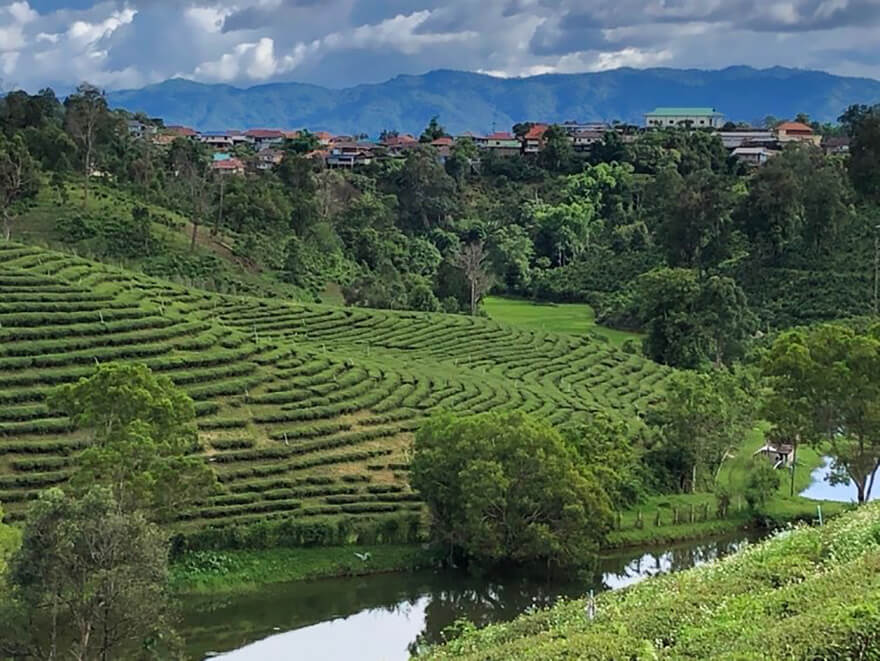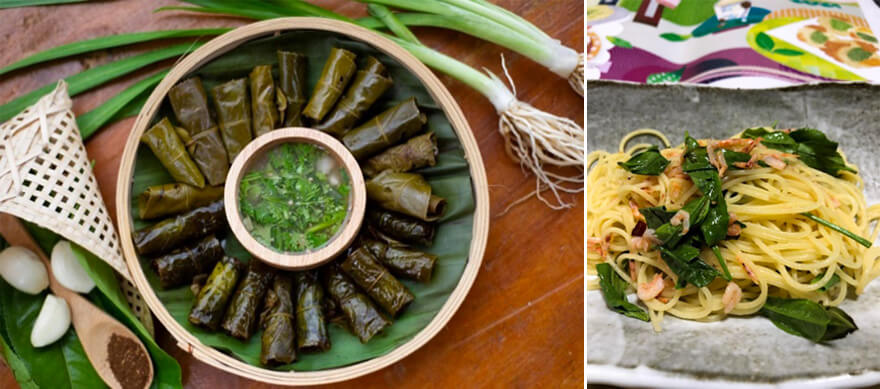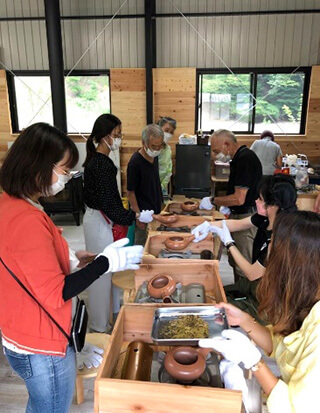International
seikabutsu
Projects Outputs

update:February 20, 2023

◉ Assoc. Prof. Dr. Amnaj Khaokhrueamuang University of Shizuoka
- Program
- 2020 International Grant Program
- Project Title
- Revitalizing Tea Industry Community through Gastronomical Tea Tourism

- Representative
- Assoc. Prof. Dr. Amnaj Khaokhrueamuang University of Shizuoka
From Garden to Dish, Tea is More Than Just a Drink!
When we think about tea, the image of a beverage probably pops into our heads. Tea is the most consumed beverage after water, with more than three billion people regularly drinking it. And yet the culinary image of tea is not very distinctive, particularly in the more than 60 countries that grow the plant. Since the beginning of the 21st century, the global tea industry has developed rapidly, and tea plantations have expanded worldwide. Despite this, international tea tourism is still in its infancy, especially as a form of gastronomic tourism that can add value to tea products and support tea-growing communities.
Gastronomy is the art of cooking and eating fine foods. As an art, it entails the study of the relationship between culture and food. In gastronomic tourism, the traveler’s experience is linked to food and culinary activities. Alongside the consumption of authentic, traditional, and innovative foods, gastronomic tourism often involves visiting local producers, participating in food festivals, and attending cooking classes. The United Nations World Tourism Organization (UNWTO) believes that gastronomic tourism can provide the following benefits:
1.Differentiation and unique positioning of a region.
2.New values and experiences for visitors.
3.Implementation of tourist activities in less-developed regions and those lacking facilities (even small villages).
4.High revenue for the region and a desire to return among visitors.
This project aims to encourage tea-growing villages to take advantage of gastronomy and tourism to develop their operations and rejuvenate their communities. The gastronomic tea tourism exchange program between Thailand and Japan is an excellent model to spread this notion to other tea communities worldwide. In Thailand and Japan, tea-growing communities have faced a decline in the tea industry due to low prices and a lack of young farmers. In northern Thailand, tourism is used to generate more income and add value to tea. In Japan, the aging population and a low birthrate cause domestic tourism and tea-producing communities to decline.

In recent years, interest in gastronomic tourism has grown thanks to the promotion of regional identity, economic revitalization, and heritage conservation. Destinations worldwide are now developing strategies to create a culinary identity that will significantly influence tourists’ decisions to travel. Tea is among the agricultural products used to create distinctive gastronomic experiences and can be a tool to revitalize both the tourism industry and farming communities. Therefore, gastronomic tea tourism has made declining tea-producing villages turn tea culture into tourism products. The exchange program in Thailand and Japan has created ideas for tea-related products that can strengthen small enterprises in tea-growing communities. The case studies are Phaya Phrai village in Chiang Rai province, Thailand (Figure 1), and Umegashima in Shizuoka Prefecture, Japan (Figure 2).
Umegashima is a highland tea-growing community in Shizuoka. For over a century, it has benefited from hot springs tourism, but the decline in domestic tourists has created problems, leading to stagnation. Attracting international tourists may now be required. As part of the foreign exchange project, the village plans to rejuvenate both tourism and the tea industry by using gastronomic tea tourism to target Thai visitors. Phaya Phrai is a highland tea-growing village in Chiang Rai that requires domestic tourists and can benefit from the lessons Umegashima learned during the initial stage of its tourism business. Thus, international exchange can offer important insights to Phaya Phrai.
The commodification of tea culture in tourism: notions of gastronomic tea tourism development in the exchange project
The project exhibits four elements of the commodification of tea culture in tourism: 1) tea spaces, 2) tea communities, 3) tea products and services, and 4) tea-related activities. Commodifying tea culture means changing the culture of tea into tourism products based on the following elements.
1.Tea spaces
Tea spaces play a significant role in attracting tourists and providing the ingredients for tea cuisines. Tea spaces include not only the fields but also the agroecosystem of the whole farm, in which tea is the primary plant. Thus, a gastronomic tea tourism experience relies on the agricultural calendar, which indicates the harvest period of different farm products. The calendar guides tourists in participating in farming activities, such as tea picking and fruit and vegetable harvesting. Tea spaces are also linked to other tourism resources by tourism routes (e.g., waterfalls, hot springs, farms, accommodations, and restaurants).
In Umegashima, the project created four gastronomic tea tourism trails for tourists to access by bus. The maps combine tea-related attractions and places where tourists can experience tea cuisine. They also provide information on buses for both Japanese and international tourists, who can take the bus from the Shizuoka Station and get off at the beginning of the selected walking route. This initiative aims to increase the number of tourists, strengthen the community, and support the local bus company.
Umegashima’s gastronomic tea tourism route maps have encouraged Phaya Phrai to develop the village’s tea spaces by adapting the Japanese team’s ideas. The villagers thus surveyed the resources related to the tea spaces to create tourism routes. They built a path to the ancient tea tree and the traditional bamboo hut. They constructed a tourism information center to welcome and provide visitors with information and maps.
In Umegashima, five farms collaborate with the project: the Sugiyama tea and wasabi farm, the Umegashima Club tea factory, the MUSH Shimura farm, the Umegashima Tenku farm, and the Akiyama organic tea garden. These places are found on the walking tour maps. The Sugiyama tea and wasabi farm runs a program for experiencing tea production and wasabi cultivation. The Umegashima Club offers tea-making activities, including roasting Hojicha tea and blending Chai tea. The MUSH Shimura farm and Umegashima Tenku farm run Shitake mushroom picking programs. Finally, the Akiyama organic tea garden is where the Kakurecha tea association organizes its tea-picking and tea-making activities.
2.Tea communities
Tea communities are groups of producers or farmer households that live in the same tea spaces. They are both tangible and intangible. The tangible aspect consists of producers’ farmhouses and tea factories, which can be commoditized as tea lodges, homestays, or farm stays. The intangible aspect is represented by the community’s customs, beliefs, livelihoods, and lifestyles.
Using the tangible and intangible aspects of tea communities to develop gastronomic tea tourism requires skills in culinary and service management that the young generation of tea producers will have to practice. This entails engaging with all the trends in the tourism and tea industries. For example, one can provide a unique tea cuisine menu at accommodations or restaurants or operate tea tourism programs in tea gardens and tea factories. Creating innovative food based on local identity is crucial for branding tea communities in the context of gastronomic tea tourism because people are attracted to differences rather than similarities. This insight derives from the sharing of local tea recipes between Umegashima and Phaya Phrai.

In Phaya Phrai, the local chiefs teach the villagers how to create unique tea cuisine that represents the Akha identity (Figure 3). This skill in cooking innovative tea dishes has been passed on to teenagers and is expected to be shared globally. One example is the Khanom Chan Cha Thai, the traditional Thai tea-layered cake served with Umegashima’s black tea syrup. This recipe has been introduced to Japan through the exchange activities. Furthermore, participants from Japan have been teaching traditional Japanese desserts, such as green tea Kuzu and Dango, to Phaya Phrai villagers.
In Umegashima, a chief of a Japanese-style inn, Onokisou, has created various tea cuisine menus for the project. Some dishes, such as the peperoncino tea spaghetti, were used for exchanging ideas with Phaya Phrai. Creating tea dishes and serving them to tourists has been gradually encouraged in some accommodations, starting with the project member’s Yunoshimakan, while the Ryokan offers the black tea Chabu Chabu. Most accommodations in the community can offer tea cuisine. Around ten of these collaborated with the project to put information in the guidebook and the walking route maps.
Beyond the exchange, the project has encouraged community members and outsiders to create various tea-based food products and activities, especially in Japan. For example, the Kakurecha tea association produced fermented tea leaves for cuisine, which is a unique project. The UmegashimaTenku farm used Umegashima tea as an ingredient for new tea dishes to attract visitors to experience mushroom picking. They offered Shitake pizza with green tea-steamed rice and green tea Dango at the farm’s barbecue house. In Yaizu City, a temple manager adapted the gastronomic tea tourism concept to create tourism activities to promote the temple.

As the commodification progressed, tea products and services were created based on tea spaces and communities. Examples include tea souvenirs, a tea farmer restaurant, and a package tour of tea trails. One of the project’s achievements is creating a variety of healthy tea cuisines and tea cocktails, including a tea pairing menu. The project’s cookbooks for Umegashima and Phaya Phrai offer new ways of looking at tea as a valuable ingredient in food and beverages. This new approach requires innovative ideas, from garden-fresh tea leaves to various processed tea products (e.g., green tea, black tea, tea powder, pickled tea, tea oil, and tea syrup), which can be made using other local farm products and natural ingredients, such as herbs. The cookbooks include Phaya Phrai’s traditional ethnic tea cuisine of Akha, such as Moo Ho Bai Cha (pork wrapped in tea leaves) (Figure 4), and Umegashima’s Western dishes with local Japanese ingredients, such as peperoncino tea spaghetti with Sakura shrimp (Figure 5). More than ten of the recipes that the project developed through the exchange of ideas can be cooked at home or in restaurants.
In terms of cooking, tea does not go well with meat like pork because it makes it harder. However, the meat will be tender when the animals are raised with tea. This knowledge is found in the Shizuoka Brand Tea Pork story about pigs drinking green tea. One of the hot springs restaurants in Umegashima served tea pork cutlet and used the story of this culinary innovation to represent the place’s image. Thus, creating tea products requires drawing from a local identity that focuses not only on heritage but also on new elements that reinterpret a place’s meaning rather than merely presenting information. Storytelling can thus become a powerful branding tool to motivate tourists to visit the destination and influence consumer purchase decisions.
4.Tea-related activities
Phaya Phrai is an ideal example of UNWTO’s claim that gastronomic tourism can be implemented in less-developed regions. Gastronomic tea tourism-related activities generate attractiveness for a community. Even in a declining destination such as Umegashima, gastronomic tea tourism plays a significant role as a new strategy to attract visitors. Creating gastronomic activities in tea spaces and tea communities involves food from tea garden to dish. Tourists can learn how to grow and nurture tea plants, harvest tea leaves, process tea products, cook tea sweets, brew tea, and even taste the tea paired with food. These activities can support farmers and local entrepreneurs. For example, volunteers work on tea farms, tourists pick tea leaves for cooking, and students make roasted tea. Drawing on these activities, the tea community can offer tourists the experience of more tea-related products, such as tea cooking classes, tea brewing courses, and tea souvenirs workshops.
Furthermore, tea-related gastronomic tourism can attract repeat visitors interested in the taste of food and the challenge of trying new things, such as tasting new tea dish menus and participating in tea learning programs or food-based workshops. Thus, implementing gastronomic tea tourism strategies to revitalize the tea communities requires creating new tourist products and activities (e.g., changing the tea cuisine menu). This notion derives from the project’s seminar on gastronomic tourism and the inspiring talk on food businesses given to university students by the local chief in Chiang Rai.
Achievements and future plans

The project’s achievements resulting from the exchanges concerning gastronomic tea tourism lead to the future development of the tea and tourism industry in the two locales.
In Phaya Phrai, the project expects the growth of the tourism business to be led by the new generation of tea producers in the next three to five years. The project supports new tourism businesses and encourages young tea farmers and entrepreneurs to create tourist products (e.g., tea cuisine menus, beverages, and musical boxsets as souvenirs). Furthermore, the young have collaborated with the project members to build an image of the village as a gastronomic tea tourism destination by producing music and songs, making a promotional video and a website, and creating the guidebook, the route map, and the cookbook. They have built the tourism information center and the walkways to the ancient tea tree. Regarding hospitality service in restaurants and accommodations, they have learned from Umegashima and Japan more broadly. For example, they now serve the Akha individual set menu like a Japanese meal service resulting from the exchange activity on having tea cuisine between Japanese and Thai (Figure 6). These achievements have strengthened the residents’ commitment, especially that of young people, including tea farmers and students. This result has taken root in the hearts of villagers like a small tea tree that will keep growing in the future.
In Umegashima, the long-term vision involves reversing the decline of the tea industry and hot springs tourism by increasing the number of international tourists. To this end, the project provides information in English and Thai. Thai visitors interested in Japanese tea and culinary culture are the primary target. For Japan, Thai tourists are a priority market among Asian nations, following China, South Korea, Taiwan, and Hong Kong. Thai tourists are highly interested in food experiences and Japanese tea. Thus, targeting them through gastronomic tea tourism holds considerable potential. However, receiving foreign tourists is a challenge for Umegashima because of the lack of young people. Thus, one of the project’s goals is to empower senior citizens in creating tourism businesses and attract young people from outside the community to collaborate with residents in the tea and tourism industries. Although few young people participated in the exchange activities, such as a sixteen-year-old girl who visited Phaya Phrai on behalf of her mother, the project hopes that the initiatives put in place will benefit the village in the future.
A strengthening global tea industry, from East to West

In addition to the exchanges between the two countries, the project has extended the tea industry and tourism networks through business, educational programs, and global community development. Regarding business, the project members exhibited the tea products from Japan and Thailand at the THAIFEX - ANUGA ASIA 2022, the largest international food and beverage tradeshow with more than 50,000 visitors from over 100 countries, which was held in Bangkok, Thailand, between May 24 and 28, 2022. At this event, the project promoted gastronomic tea tourism through flyers, the project’s Facebook page, and the tea products of Umegashima and Phaya Phrai.
Furthermore, members displayed the project outcomes at the World Green Tea Festival in Shizuoka, in October 2022. On this occasion, representatives of Thailand’s tea industry networks participated in an exchange with Umegashima and supported the exhibition.
Regarding educational activities, the project organized seminars, special lectures, and farm trips for university students, academics, and the public. An inspirational talk on tea and gastronomy was organized for the students of Thailand’s Mae Fah Luang University and the public; the talk took place on site and on Facebook Live. The project representative gave a lecture on gastronomy and tea tourism for Japanese students at the University of Shizuoka and for Chinese students at Guangxi Vocational and Technical College. The Thai team organized a tea learning program for exchange students from India, which allowed them to experience gastronomic tea tourism at Phaya Phrai as pilot tourists. The Japanese team organized a fam trip to monitor and promote the gastronomic tea tour in Umegashima. Participants were nine international tourists from different nations including Thailand, Taiwan, Vietnam, Malaysia, Myanmar, Kazakhstan, and France. They participated in learning tea cultivation, having creative tea cuisines, and making the tea such as Hojicha (Figure 7). Furthermore, the project inspired setting the academic networks on gastronomy and tea tourism with Universities in Turkey, Kazakhstan, and Thailand for future collaboration.
For global community development, the project published a chapter in The Routledge Handbook of Tea Tourism that discusses the literature on gastronomic tea tourism and several case studies from across the world. In Thailand, a television program broadcasted a piece on the tea industry and tourism in Umegashima and Phaya Phrai as part of the project. The project shared the experience of working on a gastronomical tea tourism exchange to support Chiang Rai as the tea-producing region for being a UNESCO Creative Cities for Design. The project extends the gastronomical tea tourism concept as a tool for global tea community development to the International Working Group on Tea Tourism, whose members are from worldwide tea-producing and consuming countries such as China, India, Sri Lanka, Indonesia, Malaysia, Thailand, Myanmar, United Kingdom, Germany and Canada.
After the project ends, its representative intends to present the lessons learned to a tea-producing community in Europe such as Turkey. This movement is the expansion of tea industry networks from the East to the West.
The concept of gastronomic tea tourism has gradually spread over the two years of implementation of the project funded by the Toyota Foundation. It is now acknowledged not only among tea communities but also among food-related businesses and educational institutes that work on tea. The project hopes to contribute to the realization of the United Nations’ sustainable development goals, notably the elimination of poverty and hunger.
